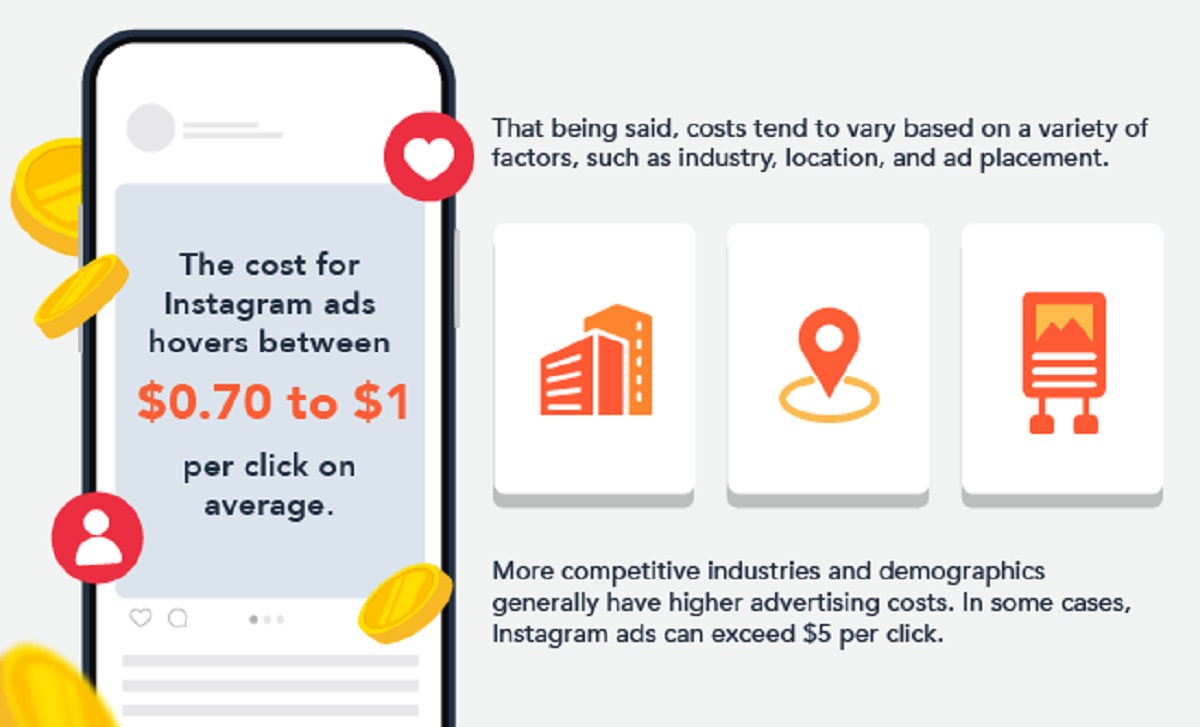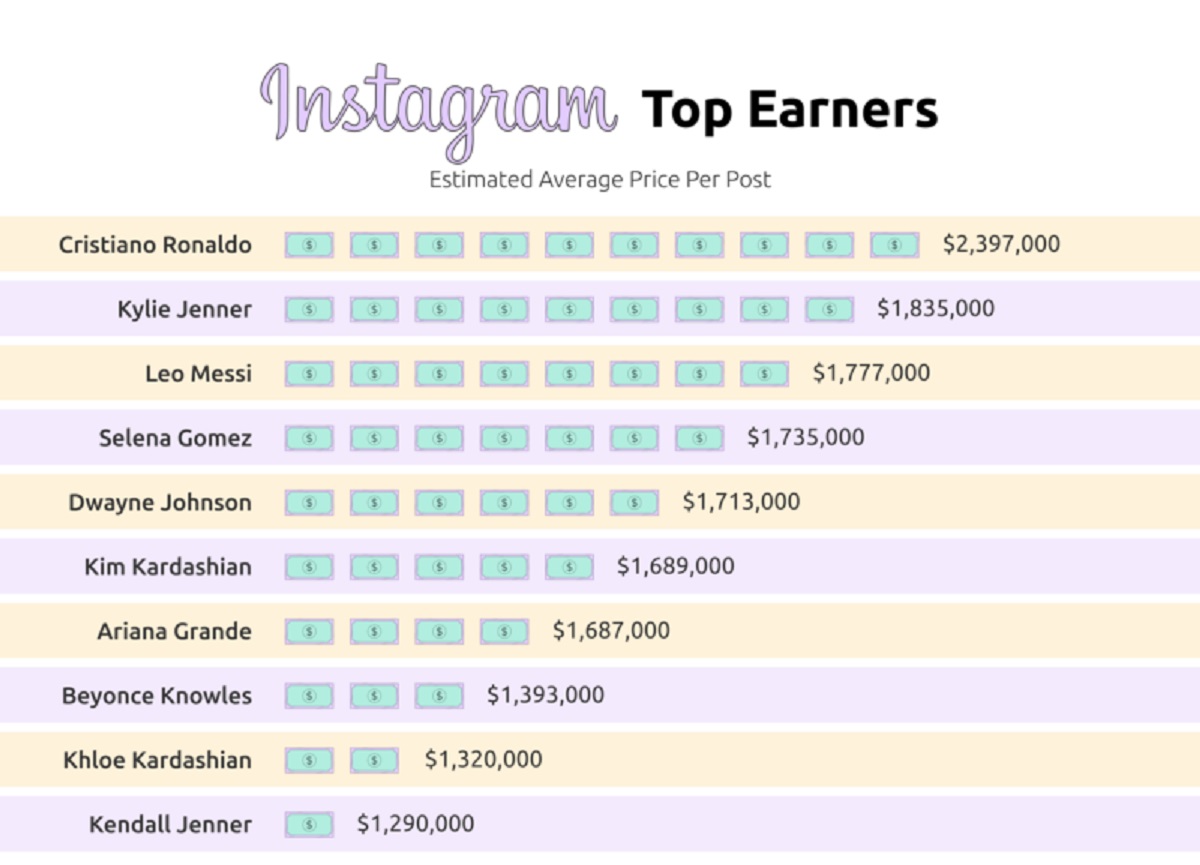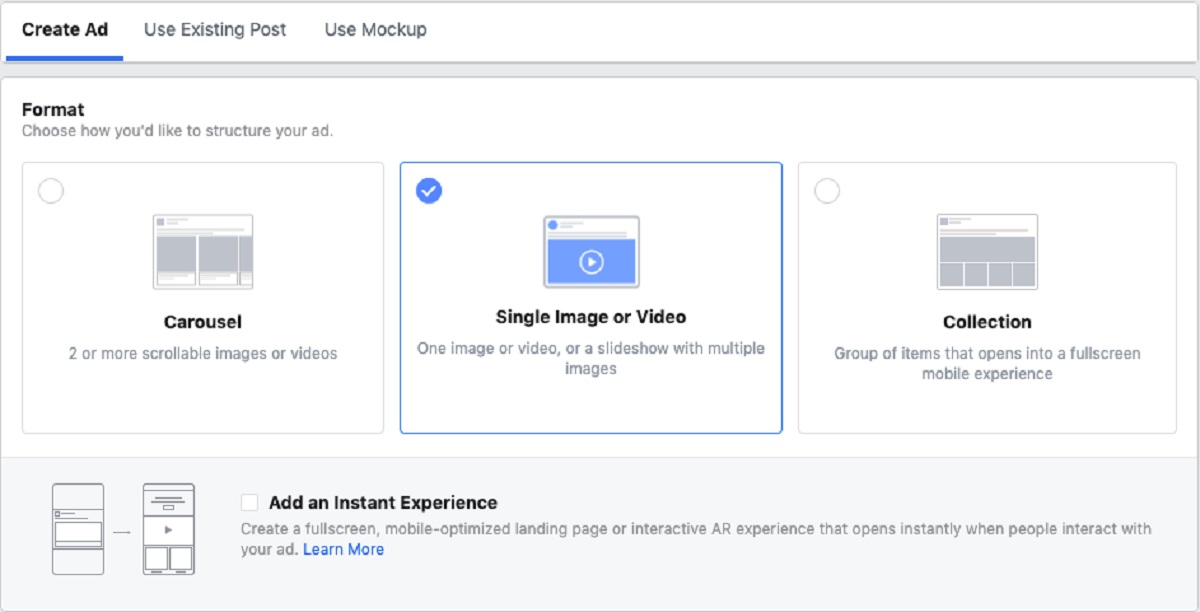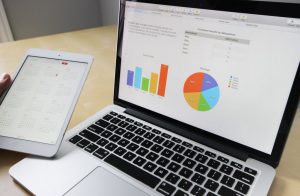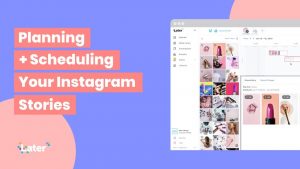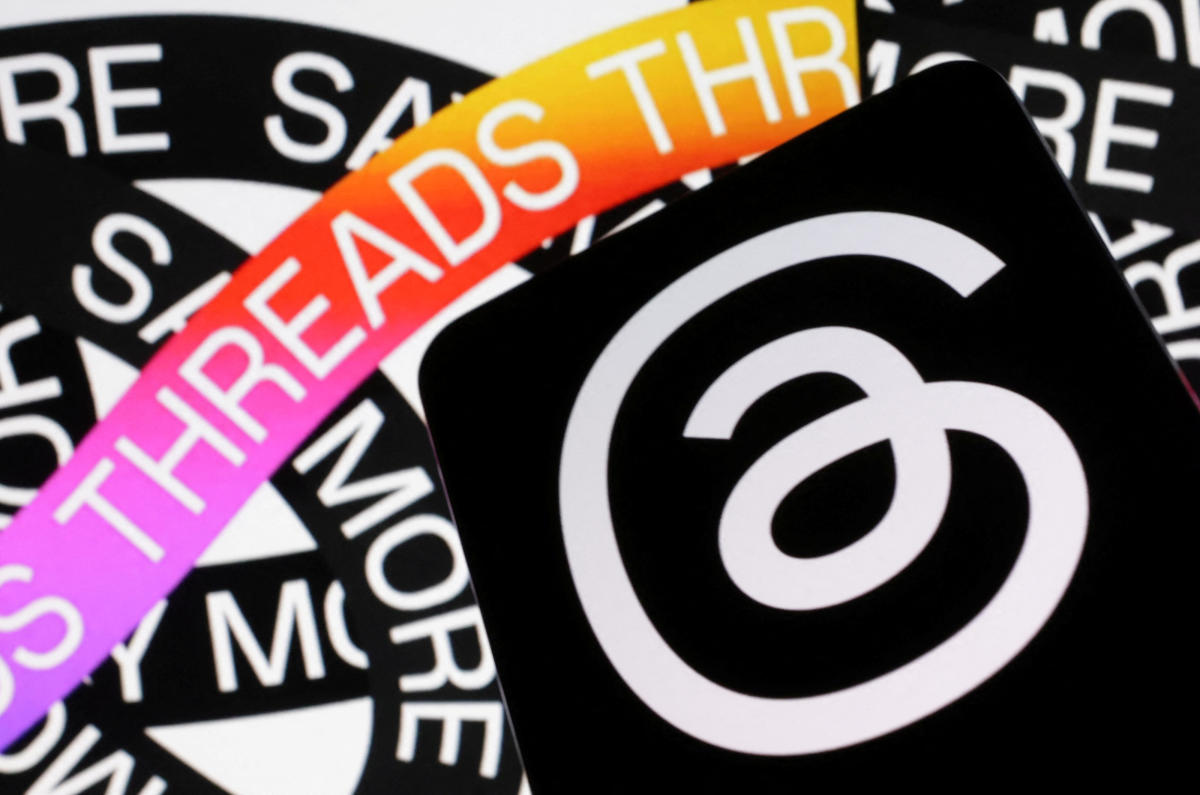Introduction
Instagram has become one of the most popular social media platforms for businesses to promote their products and services. With its wide user base and visually-driven format, Instagram provides a highly effective advertising platform for brands looking to reach their target audience. However, one of the key considerations for businesses is the cost of running ads on Instagram.
In this article, we will explore the various factors that influence the cost of Instagram ads and provide insights on how businesses can optimize their ad spending. From ad objectives and pricing to ad formats, placement options, and target audience considerations, we will cover everything you need to know to make informed decisions about your Instagram ad budget.
Whether you’re a small business owner just starting out or a seasoned marketer looking to expand your reach on Instagram, understanding the cost dynamics of advertising on the platform is crucial for achieving the best possible return on investment (ROI).
Many factors come into play when determining the cost of running an ad campaign on Instagram. These factors can include the ad objectives, chosen ad format, ad placement, target audience, and even the level of competition within your industry. Being aware of these factors can help you make strategic decisions about your ad spend and maximize the impact of your campaigns.
So, let’s dive in and explore the different factors that influence the cost of Instagram ads and learn how you can optimize your ad budget to get the most out of your advertising efforts on this popular platform.
Factors that Influence the Cost of Instagram Ads
Several factors contribute to the cost of running ads on Instagram. Understanding these factors is essential for businesses to plan and optimize their ad budgets effectively. Let’s explore the key factors that influence the cost of Instagram ads:
1. Ad Objectives: The objectives you set for your Instagram ads can impact their cost. Different objectives, such as brand awareness, website traffic, or lead generation, may require different ad types and targeting options, which can affect pricing.
2. Ad Format: Instagram offers various ad formats, including photo ads, video ads, carousel ads, and story ads. The cost of running each ad format may differ due to factors such as production complexity, placement availability, and user engagement rates.
3. Ad Placement: Instagram provides different ad placements, such as the feed, stories, and Explore tab. The cost of each placement can vary depending on factors like visibility, user engagement, and competition for ad space.
4. Target Audience: The size and targeting specificity of your desired audience can influence the cost of your Instagram ads. Highly targeted audiences with specific demographics or interests may have higher competition and, therefore, higher costs.
5. Seasonality: Certain seasons or events, such as holidays or shopping seasons, can impact the cost of Instagram ads. Increased competition during these periods may drive up prices, requiring businesses to adjust their budgets accordingly.
6. Ad Competition: The level of competition in your industry or niche can affect ad costs. Industries with high competition may have higher bid prices, requiring businesses to be strategic in their ad targeting and bidding strategies.
7. Ad Performance: The performance of your Instagram ads, including click-through rates (CTR) and engagement rates, can influence the cost of your future ads. Higher-performing ads may have lower costs, as platforms like Instagram prioritize ads that deliver value and relevance to users.
8. Ad Duration and Frequency: The duration and frequency at which you run your ads can impact their cost. Running ads for longer periods or at higher frequencies may require a larger budget to maintain visibility and reach your target audience consistently.
By considering these factors and making informed decisions, businesses can effectively manage their Instagram ad budgets and maximize the impact of their campaigns. In the next sections, we will explore the relationship between ad objectives and pricing, the different Instagram ad formats and their costs, and strategies for optimizing your ad costs on the platform.
Ad Objectives and Pricing
Defining clear objectives for your Instagram ads is crucial for determining pricing and optimizing your ad campaigns. Instagram provides a range of objectives to choose from, each with its own pricing structure. Let’s explore some common ad objectives and their impact on pricing:
1. Brand Awareness: If your goal is to increase brand visibility and reach a larger audience, you can choose the brand awareness objective. Instagram will optimize your ad delivery to maximize reach and impressions. Pricing for brand awareness ads is typically based on cost per thousand impressions (CPM), meaning you pay for every thousand impressions your ad receives.
2. Reach: Similar to brand awareness, the reach objective aims to maximize the number of unique users who will see your ad. This objective is ideal if you want to target a specific audience pool without focusing on engagement. Pricing for reach ads is also based on CPM.
3. Traffic: If driving traffic to your website or a specific landing page is your priority, the traffic objective is suitable. With this objective, Instagram optimizes your ad delivery to generate clicks that lead users to your desired destination. Pricing for traffic ads is typically based on cost per click (CPC). You pay for each click your ad receives.
4. Engagement: Engagement ads aim to increase user interaction with your Instagram content, such as likes, comments, or shares. This objective is ideal for businesses looking to boost their social media presence and encourage user participation. Pricing for engagement ads is generally based on CPC or cost per engagement (CPE).
5. Conversions: The conversions objective is suitable for businesses focused on driving specific actions, like making a purchase or filling out a form. Instagram will optimize your ad delivery to maximize conversions by showing your ads to people who are more likely to take the desired action. Pricing for conversions ads can vary, depending on the bidding strategy you choose, such as cost per acquisition (CPA) or cost per conversion.
It’s important to determine the most relevant objective for your ad campaign and align it with your overall marketing goals. Each objective comes with its own pricing structure, and selecting the right one ensures that you pay for the results that matter most to your business.
Remember that your ad objectives should align with your target audience and desired outcomes. By setting clear objectives and understanding the associated pricing, you can optimize your Instagram ad spending and achieve better ROI from your campaigns.
Cost per Click (CPC) vs. Cost per Impression (CPM)
When running Instagram ads, businesses have the option to choose between two common pricing models: cost per click (CPC) and cost per impression (CPM). Each model has its own benefits and considerations, and understanding the differences can help you make informed decisions about your ad budget. Let’s explore CPC and CPM in more detail:
Cost per Click (CPC):
Under the CPC pricing model, businesses are charged for each click their ad receives. This means you pay only when a user taps or clicks on your ad. CPC is a popular choice for advertisers who prioritize driving website traffic, generating leads, or encouraging specific user actions. It allows businesses to pay for measurable engagement rather than impressions.
The price you pay for each click can vary depending on factors such as ad relevance, competition, and targeting specificity. A higher CPC generally indicates a more competitive market or audience, while a lower CPC may mean less competition or a less targeted audience.
It’s important to continuously monitor and optimize your ads’ performance when using CPC pricing. By analyzing metrics such as click-through rates (CTR), conversion rates, and overall campaign performance, you can make data-driven decisions to improve ad targeting, creative elements, and bidding strategies. This will help you maximize the effectiveness of your ad spend and achieve better results.
Cost per Impression (CPM):
In contrast to CPC, the CPM pricing model charges businesses for every thousand impressions their ad receives. An impression refers to each time your ad is displayed on a user’s screen, regardless of whether they interact with it. CPM is commonly used for brand awareness campaigns, as it focuses on maximizing the reach and visibility of your ads.
Pricing for CPM can vary based on factors like ad placement, target audience, competition, and seasonality. It’s important to note that CPM does not guarantee clicks or specific user actions. Businesses that choose CPM should carefully evaluate their campaign objectives and target metrics to ensure they are effectively reaching their desired audience and generating the desired brand exposure.
When deciding between CPC and CPM, consider your campaign goals, budget, and target audience. If you prioritize driving specific actions or engagement, CPC may be the ideal choice. On the other hand, if you aim to maximize brand visibility and reach a wider audience, CPM can be more suitable.
Remember that regardless of the pricing model you choose, monitoring and optimizing your ad performance is vital. Regularly assess your ads’ effectiveness, make necessary adjustments, and leverage data insights to improve your overall ad strategy.
Instagram Ad Formats and Pricing
Instagram offers a variety of ad formats to suit different campaign goals and engage users in unique ways. Each ad format has its own pricing structure, providing businesses with flexibility when planning their Instagram ad budget. Let’s explore some popular Instagram ad formats and their pricing considerations:
1. Photo Ads:
Photo ads are simple yet highly effective in capturing users’ attention. They usually consist of a single image with a caption and a call-to-action button. Pricing for photo ads is typically based on factors such as ad placement, audience targeting, and ad competition.
2. Video Ads:
Video ads on Instagram allow businesses to tell a more immersive and engaging story. They can be up to 60 seconds long and provide an opportunity to showcase products, demonstrate features, or share compelling narratives. Video ad pricing is influenced by factors like video length, production quality, audience targeting, and ad placement.
3. Carousel Ads:
Carousel ads enable businesses to showcase multiple images or videos within a single ad unit. Users can swipe through the carousel to view different content pieces. Pricing for carousel ads is determined by factors like the number of images or videos included, ad placement, target audience, and competition.
4. Story Ads:
Story ads appear in between users’ Instagram stories and offer an immersive, full-screen experience. They can include images, videos, and interactive elements like polls or swipe-up links. Story ad pricing depends on factors such as ad placement, targeting, ad engagement, and competition for story ad placement.
5. Collection Ads:
Collection ads allow businesses to showcase a collection of products within a single ad unit. When users tap on the ad, they are taken to an instant experience that offers a more interactive and seamless shopping experience. Pricing for collection ads is influenced by factors like ad placement, targeting, audience engagement, and competition.
6. Explore Ads:
Explore ads appear in the Explore tab of the Instagram app, allowing businesses to reach users who are actively seeking new content and discoveries. Pricing for Explore ads is influenced by factors such as ad placement, targeting, engagement rates, and competition for ad space within the Explore tab.
It’s important to consider your campaign goals, target audience, and available budget when choosing the most suitable ad format. Some formats may require higher production costs, while others may drive better engagement or reach specific audience segments more effectively.
Regardless of the ad format you choose, regularly monitoring and optimizing your ad performance is essential. Analyze metrics like impressions, clicks, engagement rates, and conversions to make data-driven decisions that will help you improve your ad targeting, creative elements, and overall campaign results.
Ad Placement and Pricing
Ad placement plays a crucial role in the success of your Instagram advertising campaigns. Choosing the right placement option allows you to effectively reach your target audience and achieve your campaign objectives. Additionally, different ad placements on Instagram come with varying pricing considerations. Let’s explore some key ad placement options and their pricing dynamics:
1. Feed:
The feed is the main section of the Instagram app, where users scroll through images and videos posted by accounts they follow. Ads placed within the feed seamlessly blend in with organic content, providing an opportunity for high visibility. Pricing for feed ads depends on factors such as audience targeting, ad engagement, and competition for ad space within the feed.
2. Stories:
Instagram Stories have gained immense popularity, with millions of users posting and watching stories daily. Placing ads within Stories allows businesses to reach a captive audience in a full-screen, immersive format. Pricing for story ads is influenced by factors like ad engagement rates, ad placement, targeting, and competition for ad space within Stories.
3. Explore:
The Explore tab on Instagram is where users discover new content tailored to their interests. Ads placed within Explore can help businesses reach users who are actively seeking new products, brands, or experiences. Pricing for Explore ads depends on factors such as ad engagement, ad placement, targeting, and competition for ad space within Explore.
4. Reels:
Instagram Reels are short-form videos that offer businesses an opportunity to engage with users through creative and entertaining content. Reels ads are typically shown in between user-generated Reels. As Reels gain popularity, businesses can leverage this placement option to reach a growing audience. Pricing for Reels ads is influenced by factors like ad engagement, targeting, and competition for Reels ad placement.
5. IGTV:
IGTV is a platform within Instagram where users can watch long-form videos. Businesses can place ads within IGTV to reach users who are actively consuming video content. Pricing for IGTV ads depends on factors such as ad engagement, targeting, ad placement, and competition for ad space within IGTV.
When choosing ad placements, consider your campaign goals, target audience, and the nature of the content you are promoting. Each placement option offers unique advantages and may be more effective for specific objectives. Analyzing your target audience’s behavior and preferences can help you determine the optimal ad placements for your campaigns.
It’s worth noting that the pricing for ad placements can vary based on factors such as audience targeting, ad engagement rates, competition, and demand. Keeping an eye on ad performance metrics, testing different placements, and optimizing your campaigns accordingly can help you achieve better results and optimize your ad spending.
Target Audience and Pricing
Defining and reaching the right target audience is crucial for the success of your Instagram advertising campaigns. The more specific and relevant your audience targeting is, the higher the chances of achieving your campaign objectives. However, the cost of reaching your desired target audience on Instagram can vary based on several factors. Let’s explore how target audience influences pricing in Instagram ads:
1. Audience Size:
The size of your target audience can impact the pricing of your Instagram ads. Smaller, niche audiences often have less competition, which can result in lower advertising costs. On the other hand, larger audiences may have more advertisers vying for their attention, driving up the pricing. It’s important to strike a balance between audience size and targeting specificity to optimize your ad costs and reach the most relevant users.
2. Targeting Specificity:
The level of targeting specificity you choose for your Instagram ads can influence pricing. Highly specific targeting, such as demographics, interests, behaviors, or custom audiences, can narrow down your audience but may come with a higher cost per impression (CPM) or cost per click (CPC). This is because highly targeted audiences are often more sought after by advertisers, resulting in increased competition for ad space.
3. Ad Relevance:
The relevance of your ads to your target audience can affect pricing. When you create ads that resonate with your audience’s interests and preferences, users are more likely to engage with them. Higher ad engagement rates can lead to better ad performance and potentially lower costs. Instagram’s algorithms prioritize delivering relevant ads to users, so focusing on creating compelling, tailored content can help optimize your advertising costs.
4. Competition:
The level of competition within your target audience segment can impact pricing. If your industry or niche has high competition, it may drive up the cost of reaching your target audience on Instagram. Monitoring your competitors and adjusting your targeting and bidding strategy accordingly can help you navigate this competitive landscape and optimize your ad costs.
5. Seasonality and Trends:
Seasonal trends or specific events can influence the pricing of Instagram ads. During peak periods or holiday seasons, there may be increased competition among advertisers, resulting in higher costs. Planning your campaigns strategically, leveraging data from past performance, and adjusting your ad budget according to seasonal trends can help you optimize your ad spending.
It’s essential to continuously analyze and optimize your ad performance to ensure you are reaching the right target audience effectively. Monitor metrics such as click-through rates (CTR), engagement rates, conversions, and return on ad spend (ROAS). This data can provide insights into the effectiveness of your audience targeting and help you make informed decisions to improve your overall campaign performance.
By understanding how your target audience influences pricing in Instagram ads and continuously refining your targeting strategies, you can optimize your ad costs and maximize the impact of your campaigns on this popular social media platform.
Ways to Optimize Your Instagram Ad Costs
Running successful Instagram ad campaigns requires not only reaching your target audience effectively but also optimizing your ad costs. By implementing the following strategies, you can maximize the impact of your campaigns while minimizing unnecessary expenditures:
1. Set Clear Campaign Goals:
Clearly define your campaign goals and objectives before launching your Instagram ads. This will enable you to make informed decisions regarding budget allocation, targeting, and ad formats. Each objective may require different strategies and pricing models, so aligning your goals with your ad spend will help you optimize your costs effectively.
2. Refine Targeting:
Continuously evaluate and refine your targeting parameters to reach the most relevant audience for your ads. This helps minimize wasted impressions and ensures that your ads are shown to users who are more likely to engage and convert. Experiment with different targeting options, such as demographics, interests, behaviors, and lookalike audiences, to find the most cost-effective combinations for your campaigns.
3. Optimize Ad Creative:
Create compelling ad creative that resonates with your target audience. Use visually appealing images or videos that communicate your message effectively. A well-crafted ad can capture users’ attention and encourage engagement, potentially leading to lower costs per click or impression. Test different ad variations, run A/B tests, and analyze performance metrics to identify winning creative elements that drive optimal results.
4. Monitor and Adjust Bids:
Regularly monitor your ad performance and adjust your bids to optimize your ad costs. Analyze metrics like click-through rates (CTR), conversion rates, and return on ad spend (ROAS) to make data-driven decisions about bid adjustments. Increase your bids for high-performing ads or target audiences, and lower them for underperforming campaigns. Continuous optimization of your bids can help you strike a balance between cost and performance.
5. Leverage Ad Scheduling:
Take advantage of ad scheduling options to optimize your ad costs. Analyze data to determine the most effective times and days to run your ads. By scheduling your ads to appear during periods of high user activity or when your target audience is most likely to be online, you can increase the chances of engagement and improve the efficiency of your ad spend.
6. Test Different Ad Formats:
Experiment with various ad formats to find the ones that drive the best results for your business. Test photo ads, video ads, carousel ads, story ads, and other available formats to identify the most engaging and cost-effective options. Some formats may resonate better with your target audience or yield higher conversion rates, allowing you to optimize your ad costs and ROI.
7. Monitor Competition:
Keep an eye on your competitors and their actions on Instagram. Monitor their ad campaigns, messages, and targeting strategies. Understanding the competitive landscape can help you identify opportunities to differentiate your brand, refine your targeting, and optimize your ad costs.
8. Regularly Analyze and Optimize:
Continuously analyze your ad performance metrics, such as engagement rates, conversion rates, and Cost per Action (CPA), to identify areas for improvement. Use this data to optimize your targeting, creative, and bidding strategies. Regularly testing and optimizing your campaigns will ensure that you’re getting the most out of your ad spend and maximizing your return on investment.
By implementing these strategies, you can optimize your Instagram ad costs and achieve better results. Remember that advertising on Instagram is an iterative process, and continuous monitoring, tweaking, and improvement are essential for long-term success.
Tracking and Measuring Ad Performance
Tracking and measuring the performance of your Instagram ads is crucial for optimizing your campaigns and achieving your marketing goals. By effectively monitoring key performance metrics, you can make data-driven decisions, identify areas for improvement, and maximize the return on your ad investment. Here are some important factors to consider when tracking and measuring your Instagram ad performance:
1. Set Clear Goals and Key Performance Indicators (KPIs):
Before launching your Instagram ads, clearly define your goals and identify the key performance indicators (KPIs) that align with those goals. Whether your objective is to drive website traffic, increase brand awareness, or generate conversions, having well-defined goals and KPIs will provide a clear framework for measuring success.
2. Track Engagement Metrics:
Engagement metrics, such as likes, comments, shares, and click-through rates (CTR), can help you assess the effectiveness and resonance of your ad creative and messaging. Monitoring these metrics provides insights into how users are interacting with your ads and allows you to make adjustments to optimize engagement and increase ad performance.
3. Measure Conversion Metrics:
Conversion metrics are critical for evaluating the effectiveness of your Instagram ads in driving desired actions, such as purchases, sign-ups, or downloads. By implementing conversion tracking pixels or setting up specific conversion events, you can measure metrics like conversion rates, cost per acquisition (CPA), and return on ad spend (ROAS). These metrics help you understand the impact of your ads on your business’s bottom line.
4. Analyze Audience Insights:
Instagram provides valuable audience insights that can help you refine your targeting and messaging strategies. By analyzing demographic data, location information, and user behavior, you can better understand who is interacting with your ads and optimize your targeting to reach the most relevant audience segments. This ongoing analysis enables you to tailor your campaigns to suit the preferences and interests of your audience.
5. Conduct A/B Testing:
A/B testing allows you to compare different variables of your ad campaigns to determine which variations yield the best results. Test different elements, such as ad creative, ad copy, targeting options, and call-to-action buttons, to identify the most effective combinations. By continuously testing and optimizing, you can improve overall ad performance and drive better results.
6. Utilize Analytics Tools:
Make use of analytics tools, such as the Facebook Ads Manager or third-party platforms, to gather detailed data on your ad performance. These tools provide comprehensive insights into reach, impressions, engagement, conversions, and other vital metrics. By regularly analyzing this data and drawing actionable insights, you can optimize your campaigns and allocate your budget more efficiently.
7. Monitor Ad Frequency and Reach:
Keeping track of ad frequency and reach is essential to ensure that your ads are neither overexposed nor underseen by your target audience. High ad frequency may lead to ad fatigue, while low reach may indicate that your ads are not reaching enough people. Monitoring these metrics allows you to adjust your targeting, bid strategies, and ad rotation to maintain optimal reach and engagement levels.
8. Continuously Evaluate and Optimize:
Regularly review your ad performance metrics, identify trends, and make data-driven optimizations. Make strategic adjustments to your targeting, bidding, ad creative, and messaging based on your analysis. A continuous process of evaluation and optimization will help you refine your campaigns, reduce wasted ad spend, and improve overall ad performance.
By diligently tracking and measuring the performance of your Instagram ads, you can gain valuable insights to optimize your campaigns and achieve your marketing objectives. Utilize the available data and analytics tools to make informed decisions and drive meaningful results from your ad investments.
Conclusion
As businesses increasingly turn to Instagram to promote their products and services, understanding the factors that influence the cost of running ads on the platform is essential. By considering ad objectives, ad formats, ad placement options, target audience dynamics, and ways to optimize ad costs, businesses can make strategic decisions to allocate their ad budget effectively and achieve better ROI.
Defining clear ad objectives allows businesses to align their spending with their desired outcomes. Whether it’s increasing brand awareness, driving website traffic, or generating conversions, choosing the right objective determines the pricing structure and helps optimize your ad spend.
Ad formats play a crucial role in capturing users’ attention and driving engagement. Photo ads, video ads, carousel ads, story ads, and other formats offer unique opportunities to create compelling content that resonates with your target audience. Understanding the pricing dynamics of each format enables businesses to make informed decisions about which options will yield the best results within their budget constraints.
Ad placement on Instagram has a significant impact on the visibility and reach of your ads. Choosing the right placement, whether it’s the feed, stories, explore, reels, or IGTV, can optimize your ad performance and influence pricing. Monitoring ad placement metrics, evaluating competition, and leveraging data insights are key to maximizing the effectiveness and efficiency of your ad spend.
Targeting the right audience is crucial for achieving better results and minimizing unnecessary ad costs. Refining your target audience parameters, focusing on relevance and engagement, and monitoring the competition within your niche are vital strategies for optimizing your ad budget.
Tracking and measuring the performance of your Instagram ads provide valuable insights into ad engagement, conversions, audience behavior, and other key metrics. This data allows businesses to make data-driven decisions, optimize campaigns, and allocate budget more effectively for maximum impact.
Additionally, continuously testing and optimizing ad creative, refining targeting strategies, and leveraging ad scheduling are effective ways to optimize Instagram ad costs. By understanding the nuances of the platform, staying informed about industry trends, and monitoring competitors, businesses can refine their ad strategies and achieve better results within their budget.
In conclusion, to effectively utilize your ad budgets on Instagram, it is crucial to understand the various factors that influence pricing and optimize your campaigns accordingly. By setting clear objectives, targeting the right audience, adopting efficient strategies, and measuring performance, businesses can maximize the impact of their Instagram ads and achieve their marketing goals.







